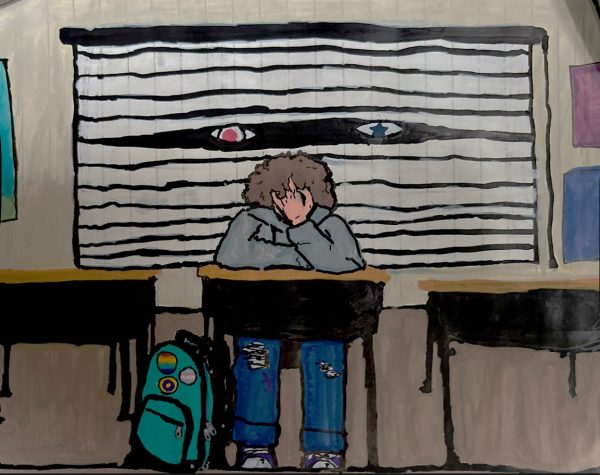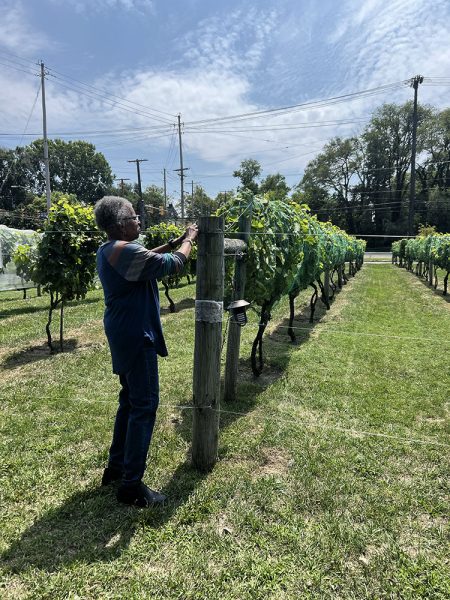Even in a Diverse School, Assimilation Can be a Formidable Force
“I see kids doing it all the time, and it can be difficult because Beachwood’s so small and [students] want to be a part of the community,” Spanish teacher Daria Cayne said.
Beachwood takes pride in its diversity and acceptance; however, some students still feel the pressure to assimilate.
Assimilation is the act of changing aspects of one’s identity, including cultural identity, to fit societal standards. Even in Beachwood, some students feel pressure to hide certain parts of their cultural identity to be more like the people around them.
This pressure can come from many sources. It can come from people who make you feel different, the lack of people around who are of the same cultural background, or even from yourself, wanting to fit in.
“Assimilation is when you get rid of what makes you unique, different and special to fit in with the majority norm,” social studies teacher Kathryn-Anne Barney said. “It could be language, religion, culture or skin tone.”
Students from minority cultures might stop wearing traditional clothes, eating the way they do at home or speaking their mother-tongue.
Some students assimilate to feel accepted, only to find that they have given up an essential part of themselves by eliminating their difference from the majority group.
“People don’t always feel like they can be themselves,” senior Prerna Mukherjee said.
This tendency is not only found in high school; it happens everywhere.
This mindset to change is caused by pressures to conform to the majority. Pressures from society bring forth a sense of shame regarding differences, causing minorities to feel a need to hide them. Historically, assimilation has wiped out entire cultures and their traditions.
But there can be a positive side to assimilation as well.
“[Assimilation is] destructive when it encourages [people] to abandon identity,” sophomore Greg Perryman said. “[It can be] constructive when [we] assimilate [our] identity into a larger group [in a way that is] inclusive, welcoming and positive.”
Assimilation in Beachwood
People do not always feel like they can be themselves.
“It’s going to vary from student to student,” Principal Paul Chase said. “I’m sure there are people who will want to assimilate. Everyone [should] know they have a right to always maintain their culture and identify.”
Other district staff members echo this view.
“I think there are situations in which people do assimilate to try to fit in, but also more students in Beachwood, in my ten years here, feel comfortable being themselves,” Director of Equity and Community Engagement Kevin Houchins said. “The more inclusive environment drew me into Beachwood.”
“One of the big things I found was that you could be accepted in Beachwood, something you don’t always find in other school districts,” he added.
Despite the welcoming environment, some feel that there is still pressure to assimilate.
“Yes, I see kids doing it all the time, and it can be difficult because Beachwood’s so small and [students] want to be a part of the community,” Spanish teacher Daria Cayne said. “Assimilation is an easy and rapid way to do it.”
“It’s also subconscious,” she added. “There are kids who try to hold on [to their culture] and not apologize for it; they also try to educate others,” she added.
Cayne started the Bison Feast and Fest in 2016, an annual fair to celebrate the diversity of the community.
Some feel that assimilation is not unique to Beachwood, and that it is part of human nature.
“Yes, because it is a reality everywhere,” sophomore Ilan Haas said.
In spite of the efforts to celebrate diversity, some students still feel a negative sense of being different, especially when there are not many people like them.
“A lot of minorities in Beachwood don’t have other people like them here,” sophomore Amelie Cotta said.
“There’s a large number of [people who are] Jewish and Caucasian,” senior Priyanka Shreshta said. “While there are many cultures, the majority is a normal American high school like in High School Musical.”
Cotta described the majority culture in Beachwood as negative.
“White culture. Privileged culture. Toxic culture, toxic meaning ignorant culture, ignorant, selfish, cold,” she said.
Cotta said that it was toxic due to the formation of cliques and people being ignorant and inconsiderate to others’ perspectives and points of views. She said that some people lack manners and are judgemental.
“I want to be very specific and clear,” Perryman said. “I believe that in Beachwood, if we are to continue to be very inclusive and welcoming in a positive force of assimilation, we cannot hold people to unrealistic standards of whiteness.”
“We need to acknowledge that the systems of our country from government to education have been built on standards of whiteness,” he added.
Perryman feels that we each have a responsibility to work against these standards.
“In our interpersonal relationship we must act in a way that we don’t unfairly hold people to standards of whiteness (such as beauty, the way one speaks, other cultural norms), that can be very destructive,” he said.
Some staff members have also felt pressure to assimilate.
“Growing up, I definitely did; growing up there was this idea of how we’re supposed to talk [and] what would make me as African American beautiful,” Barney said. “However, as I grew to love myself and culture and understand it, I stopped assimilating.”
Pressure to assimilate is not always caused by explicit hatred. Sometimes it is caused by microaggressions.
“It’s not bullying or hate though,” Shrestha said. “[People ask] questions not meant in a mean way, [which] hurt a little, [and there becomes a] need to assimilate.”
Shrestha, who is Nepali, described a particularly memorable moment when she was in elementary school.
“We eat with our hands in my culture, and I shared that with my class [at Bryden],” Shrestha said. “One little girl said ‘that’s disgusting.’”
“I wouldn’t eat with my hands for some time when I went home,” she added. “I tried to fit in… Those experiences are few and far between in Beachwood.”
There are, however, positive aspects of exposure to different cultures.
“I know cultural norms associated with the Jewish culture, just from being here, sort of assimilated to the cultural norms, I really do love that,” Perryman said.
Junior Danielle Lan explains that assimilation is unavoidable in schools with predominantly American students.
“First, we all need to speak English,” she wrote in an email. “[We] live with Americans [and we] make friends with Americans.”
Lan was born in the United States, but lived in China for most of her life before returning to the United States three years ago.
Assimilation usually means leaving something behind.
“I’ve had a journey with assimilation,” Shrestha said. “I buy different clothes [because of assimilation], like leggings instead of traditional pants.”
Shrestha moved to the U.S. from Nepal 13 years ago.
“Now I eat more American food or Italian,” she said. “In Nepal, I’d eat traditional Nepali foods; I now speak mostly English and much less Nepali than if I were still living in Nepal.”
Students try to fit in with friends.
“The things that [my peers] care about are the things that I care about,” Haas said. “For example, if my friends play a game, I play that game too.”
Assimilation can also make people hesitant to speak up.
“In some cases, I maybe haven’t expressed myself as openly,” Mukherjee said.
Some are hesitant to show their culture through food and clothing.
“I’m Russian, so a lot of the food I eat at home is not something I eat at school,” junior Alexa Zarjetskiy said. “With clothes, I sometimes see something that I’d love to wear, but I think, would I wear it at school?”
Others don’t feel pressure to leave their food at home.
“Most of the time my mom or I will pack a lunch [with Chinese food],” Lan said.
“I think people find unfamiliar cuisines to be interesting” senior Zyad Shehadeh said.
Others suggest that assimilation is a natural process when we move from one culture to another.
“Whenever I [travel], I assimilate,” senior Roberto DeMarchi said. “In a Spanish speaking culture, I speak more Spanish and I take siestas.”
Combating Assimilation
Some people have found the means of overcoming assimilation, whether through the people they surround themselves with, the activities they partake in or the pride they take in their cultural identity.
Barney advises the Multicultural Achievement Committee (MAC) program, a holistic collaborative, educational support function of Beachwood Schools. The MAC program is designed to provide students with the necessary skills and support they need to achieve success academically, emotionally and socially as well as encourage cultural awareness and pride. It helps combat assimilation by celebrating our differences as something to take pride in rather than something to be ashamed of.
“It’s for all kids. And I think it’s important to have allies from other groups. If people just want a place to vent they can do that.”
She encourages students of all races to come to her room whenever they need a break from the world. She always has an open door for them and embraces the diversity of her students. On her wall she has posted pictures drawn by students as well as her name written in multiple languages.
Some students make an effort to surround themselves with the right people to help stay true to themselves.
“[I try to have] people around me who are open to discussion, not judging,” Mukherjee said.
Other students have learned how to resist assimilation over time.
“For sure, over the years, if you’re new, you assimilate a little bit until you get acceptance,” Shehadeh said.
“With experience, I’ve realized it’s not worth trying to change something about my personality if I think it’s right,” he added.
Others make an effort to remember their heritage.
“You keep yourself from completely being absorbed into your environment and completely separated from your roots by knowing who you are,” Perryman said.
Others ignore the pressure altogether.
“I do what I like when I have free time, [even if it is] not popular,” Lan said. “I listen to the Chinese radio about Chinese history and current events, and what I should know, being Chinese.”
School is also important in teaching kids how to resist assimilation.
“There is no one right answer about how to best support newcomer students, but it is clear that schools must provide more than English language skills to help these students achieve academic success and self-sufficiency in their new country,” wrote Anne Wicks, a Director of the Education Reform Initiative in an article for the Bush Center.
The Beachwood Schools offer a number of initiatives targeted at making the district a welcoming atmosphere for minorities and limiting the pressure to assimilate.
“We can’t forget about it,” Chase said. “We have to be consistent so that kids feel it’s safe [to express their cultural identities. It’s as simple as having conversations to make sure everyone feels alright. It’s our job to get out there and continue to have those conversations.”
Houchins emphasizes the importance of courses such as African American literature and history to help students understand African American culture.
“In addition, the district offers a variety of clubs that allow students to connect with members of their affinity group,” said Houchins. “These clubs are open to anyone who wants to participate, which provides an opportunity for any student to join and learn.”
“These clubs are also encouraged to collaborate on projects where they can find shared meaning,” he added. “A big one is Many Cultures, One Bison, which celebrates our individual cultures but reminds us that we are connected in many ways.”
Another new program the district plans to implement is Diversity.edu.
“Diversity.edu is an online platform that will be [made accessible] to students from 6-12 grade,” Houchins said. “It’s a foundation to have a common vocabulary.”
“When we have conversations about equality, inclusion and diversity, we all need to have the same vocabulary,” he added. “It will equip students and families. We need to have conversations to continuously improve our community.”
Students also reflect this opinion.
“The different clubs and organizations, diversity summits [and] student forums are good ways for Beachwood to combat [assimilation],” Mukherjee said.
“I think Beachwood is currently on the path of combating [assimilation] by embracing all students’ diversity; it may not be fast, but change never happened overnight,” Barney said.
History of Assimilation in United States
Assimilation has a dark history in this country. In 1819, Congress passed the Civilization Fund Act, which established off-reservation boarding schools for Native Americans.
This act was an attempt to remove any semblance Native Americans had to their culture by
removing young Native American children from their reservations. Their culture and language were prohibited.
Captain Richard Pratt, who founded the Carlisle Indian School, described the goal of these schools: “Kill the Indian, and save the man.”
According to an article by Alia Wong published in the Atlantic, Native American parents were forced to send their children away, either by threats of violence by the government or by conditions on reservations that were so poor that parents felt they had no other choice. Children were taught by Christain missionaries.
“Over time, countless Native American children were taken from their families and homelands and placed in faraway boarding schools, a process that was often traumatic and degrading,” Wong wrote. “The act was, in effect, an effort to stamp out America’s original cultural identity and replace it with one that Europeans had, not long before, imported to the continent.”
Native Americans today lament the language and culture that was lost due to forced assimilation.
“Education was something that was done to us, not something that was provided for us,” Native American author David Treuer told Wong.
When immigration increased in the 19th century, education was used to help assimilate those immigrants deemed to be not ‘American’ enough. This mindset was largely due to nativist ideals that only white Christians are true Americans.
When millions of German and Irish immigrants came to the United States in the mid-19th century, they were met with efforts to ‘Americanize’ them through public education. These efforts continued several decades later when waves of immigrants came from Southern and Eastern Europe.
According to a study done by Stanford University, many immigrants from Europe during the mass-migration of the early 1900s changed their names to more American-sounding ones. They found that immigrants with more Americanized names were more successful in terms of school and employment.
The pressure to assimilate is also felt in modern times. For example, a study done by Pew Research Center shows that the majority of adults (59%) say that being white in America can help people be more successful.
Assimilation in Schools
Throughout history, education has been a location where assimilation was used as a cultural weapon to erase cultures viewed as foreign.
Carl Kaestle, emeritus professor of education at Brown University, wrote about this issue in his book, Pillars of the Republic: Common Schools and American Society, 1780-1860.
Kaestle described the reaction of the New York State assembly committee to a situation in the 1850s when the majority of New York City was foreign-born, primarily Irish.
“We must decompose and cleanse the impurities which rush into our midst,” the committee warned. “There is but one rectifying agent—one infallible filter—the SCHOOL.’”
In the book Children of La Frontera, Eugene E. Garcia wrote about efforts to assimilate Mexican Americans in schools.
“At that time (1900s), educators responded to increasing cultural and linguistic diversity among their students by attempting to accelerate the assimilation into the American mainstream,” he wrote. “Their mission was to Americanize immigrants by replacing their native language and culture with those of the United States. Educators confidently sought to fit newcomers into the American mold by teaching them the English language and literature, a sugar-coated version of American history, and a respect for the U.S.’s political system and civic life.”
“Although some recommend a similar approach today, it is no longer possible even to describe with confidence American culture, or to what mold educators should seek to fit all children. There is no single definition of American culture; multiple definitions have been informed by ethnic minority voices,” Garcia continued.
Garcia also noted that, “When immigrant students became shining academic stars, their success is often attributed to the values and habits of their native culture rather than their Americanization. There is some evidence that assimilation may actually inhibit academic success.”
Dr. Meridith McCoy, an assistant professor of American Studies and History at Carleton College studied this topic of assimilation in schools.
In a paper titled Teaching Historical Trauma, Assimilation Policy, and Indigenous Resilience in Middle School Social Studies Classrooms,
“Through the school’s strict English-only language policy, my great-grandfather learned to be ashamed of speaking Michif, his native language,” McCoy wrote.
“After attending Wahpeton [a boarding school], he only spoke the language in secret when he thought his children couldn’t hear. The school also kept him away from his family for extended periods of time, and the school superintendent’s authority superseded that of his parents with regards to when he could go home for family visits….For me, this forced separation of parents and children, and the subsequent disruption of community knowledge and cohesion, is how historical trauma manifests in my family’s history.”
BHS is diverse, and the school district makes an effort to combat assimilation by making an open environment for all students. Nonetheless, minority students still feel pressure to assimilate.
While students are not forced to leave their homes and families behind and are not punished for speaking their language as students were in 19th-century Indian schools, some students still feel as if they must leave behind bits of their culture.

Hiba Z. Ali began writing for the Beachcomber in fall of 2019. She covers diversity in the school. In addition to writing for the Beachcomber, she also...




!["I see kids doing it all the time, and it can be difficult because Beachwood’s so small and [students] want to be a part of the community,” Spanish teacher Daria Cayne said.](https://bcomber.org/wp-content/uploads/2020/01/IMG_1060-1-664x900.jpg)









